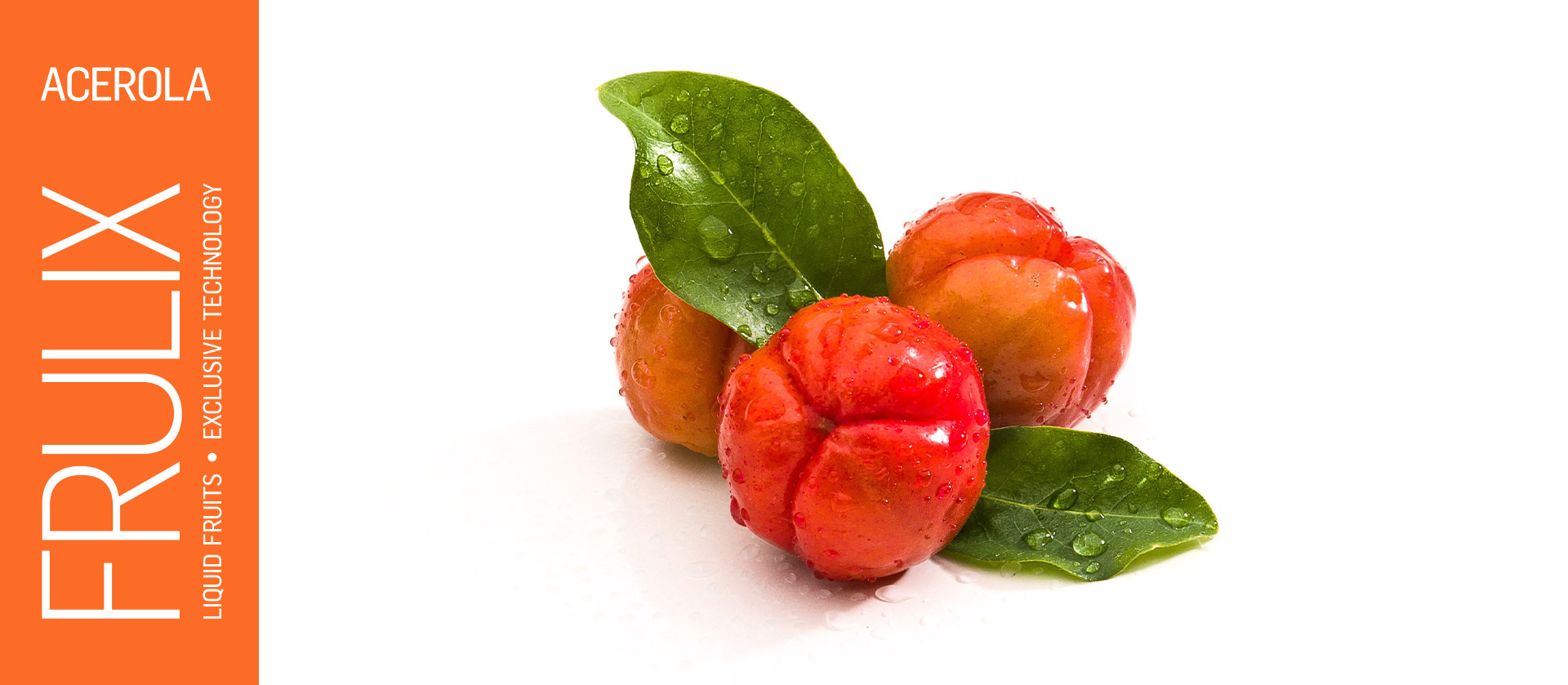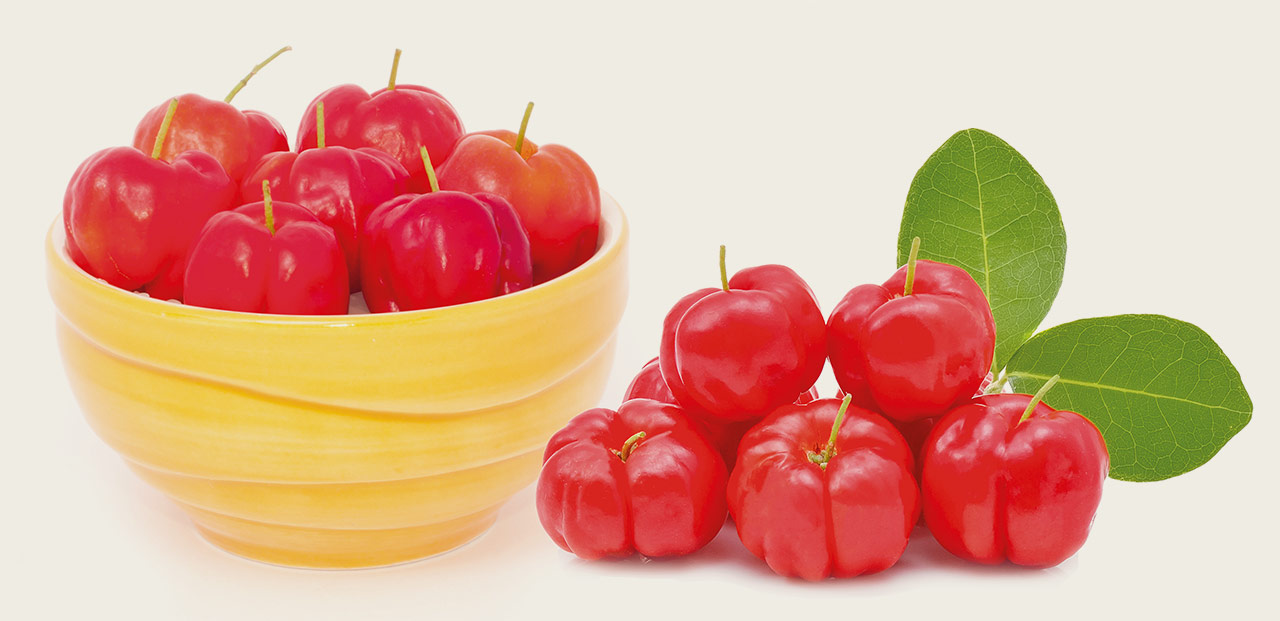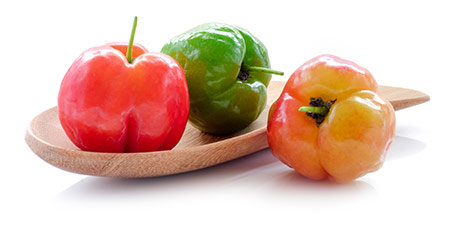
Frulix Acerola
FRULIX ACEROLA is obtained through an exclusive biotechnological process that mimics the natural ripening of the fruit. Using the fruits’ native enzymes ASSESSA transforms its pulp into a crystalline liquid with all the active ingredients of the fruit, in concentrations equivalent to those found in nature.
PRODUCED WITHOUT THE ADDITION OF SOLVENTS
INCI NAME
Malpighia Glabra (Acerola) Fruit Extract, Sodium Benzoate and Potassium Sorbate
Acerola
100 times more vitamin C than orange or lemon
Acerola, also known as “Barbados Cherry”, is a tropical fruit native to the Antilles lslands and to the north of South America and is currently cultivated in various areas around the world, including Brazil. Its cultivation was introduced to Brazil in the middle of the 1950s, with fruits brought from Puerto Rico.
The plant belongs to the Malpighiaceae family and is a bush or shrub of 2.5 m in height with a dense crown formed of small (2-8 cm) shiny dark green leaves. lts flowers range in color from pink to violet. The fruit is a drupe with a smooth surface and is divided into three segments. lts size varies from 3 to 6 cm in diameter. The external coloration varies from orange to dark red, when ripe.
The pulp is fleshy, succulent and orange-colored. Acerola achieved its current status through the discovery of its high levels of vitamin C – 100 times greater than those of oranges and lemons, 20 times greater than guavas and 1 O times greater than cashew fruits or mulberries.
As well as the high levels of vitamin C which established acerola’s fame, it also contains vitamins A, B1 and B2 in appreciable quantities, and is rich in calcium, iron and phosphorous.
Acerola is recommended for the treatment of colds, flu, liver dysfunctions, pulmonary tuberculosis, diabetes and cicatrizing problems.

Composition
Proteins (mg/L)
MINERALS
Vitamins*
*Tested after 4 months from manufacturing
As a more concetrated product, FRULIX ACEROLA should be used in smaller concentrations than those normally used when making formulas with conventional extracts.
SKIN CELLS STIMULATION
Cultures of human Keratinocytes and Fibroblasts were incubated in an appropriate medium for 48 hours, in the presence of FRULIX ACEROLA. The results shown in the figures below demonstrate that FRULIX ACEROLA stimulates the metabolism of skin cells.
STIMULATION OF FIBROBLASTS
STIMULATION OF KERATINOCYTES
STIMULATION OF COLLAGEN PRODUCTION
Fibroblast human cells were incubated in supplemented RPMI medium and the viability of the cells were evaluated using the MTT method. The cultivated cells were then incubated in multiwell microplates containing IgG, in a serum albumin medium for 24 hours. The collagen produced measured through an ELISA reader adjusted to 405 nm. The results shown in the figure below demonstrates that FRULIX ACEROLA stimulates the production of type I Collagen.
STIMULATION OF COLLAGEN I PRODUCTION
ANTIOXIDANT ACTIVITY
The antioxidant activity of FRULIX ACEROLA was also evaluated using the DPPH (2,2-difenilpicrylhidrazyl) method. The “efficient concentration” or EC50 value is defined as the concentration of substrate that causes 50% loss of the DPPH activity. The EC50 value of FRULIX ACEROLA was found to be 33.8 µg/ml.
FUNCTIONS
The vitamins, proteins and bioflavonoids present in FRULIX ACEROLA contribute to the improvement of the elasticity of the skin, and have antioxidant and dermoprotecting activity. FRULIX ACEROLA is also recommended for formulations for hair-care products such as shampoos and conditioners for its protective and nutritive qualities.
USAGE LEVELS
FRULIX ACEROLA is compatible with the majority of ingredients used in cosmetic formulations for the treatment of skin and hair and may be incorporated cold, directly into the aqueous phase of the formulas, in accordance with the suggestions of the table below. It is stable at temperatures up to 90°C, in pH conditions from 4.00 to 11.00.
Frulix exclusive process
1. The Technology
FRULIX is obtained through an exclusive biotechnological process that mimics the natural ripening of the fruit. Using the native enzymes that change the texture of the fruit during its ripening, it is possible to transform its pulp into a crystalline liquid.
2. Production of enzymes
The fruits are harvested, washed and processed into a paste. The slurry is inoculated with microorganisms and the semi-solid mass is placed to ferment. The mixture is separated and the enzymes are removed from the wort.
3. Processing the fruits
The fruits are harvested, washed and processed into the pulp. Seeds and bark are discarded. The pulp is inoculated with the Frulix Enzymes. The residues (fibers, solids) are removed and FRULIX is obtained. The product is stabilized and preserved.
4. Frulix
The clear liquid from the separation step receives preservatives, mixture and filling.



